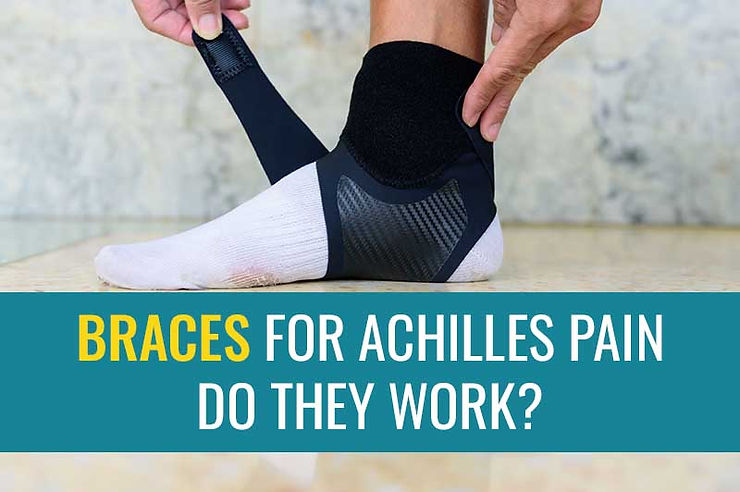Our Achilles injury patients often ask us what the best brace for Achilles tendonitis is. And then we reply, “none of them”, because braces don’t really help for Achilles tendonitis. This article explains why braces aren’t very useful and suggests another simple thing you can do to help alleviate your Achilles pain. Remember, if you need more help with an Achilles injury, you're welcome to consult one of our team via video call.

The terms tendinitis, tendonitis, tendinosis, and tendinopathy mean the same thing for all practical purposes, and we use these interchangeably in our articles.
In this article:
We've also made a video about this:
Achilles tendon anatomy
To understand the effect, or lack thereof, of a brace for Achilles tendonitis, it helps to have a quick overview of the anatomy of the Achilles tendon.

As you can see in the picture above, the calf muscles come down the back of the ankle, and the Achilles tendon connects these muscles to the heel bone.
The two foot movements that affect your Achilles tendon are dorsiflexion, when your foot moves upwards, towards your shin, such as when you’re squatting, and plantar flexion, when your foot moves downwards, such as when you go up onto your toes.

With dorsiflexion the Achilles tendon and calf muscles are stretched, and with plantar flexion the calf muscles contract and pull on the Achilles tendon.
So, it’s the up-and-down motions of the foot that affect your Achilles tendon.
Why a brace for Achilles tendonitis is not useful
An ankle brace is designed to prevent your foot from turning sideways (i.e. in and out), not from going up and down, so it has little effect on the Achilles tendon.
In any event, preventing your foot from going up and down is not good for the Achilles tendon.
First, immobilising your Achilles tendon when you have a tendonitis can often make it feel even more uncomfortable than it already is. It needs a bit of movement to get rid of the stiff feeling that often accompanies Achilles tendonitis.

Second, the reason your Achilles tendon hurts when you have Achilles tendonitis is because it has lost a bit of its strength and therefore is struggling to cope with your normal activities. Keeping it still or limiting its movement drastically will cause it to lose more strength, because it’s not getting any exercise. What it needs is an exercise programme (and therefore movement) that strikes the right balance between strengthening it back to its healthy level while not aggravating the injury further.
Sometimes, if you have a really painful Achilles tendon, it can be useful to put your foot in an orthopaedic boot (not an ankle brace) and immobilise its up-and-down movement for a brief period – no more than a week or two – to get it to calm down. Such a boot is usually prescribed for you by a doctor. But in most cases, this is not necessary, and it should definitely not be used for a long time. Here’s an article of ours that explains the ins and outs of using orthopaedic boots for Achilles tendonitis.
What you can use instead of a brace for Achilles tendon pain
Something that can be useful in terms of limiting the range of motion of your foot just a tiny bit is a very simple heel lift inside your shoe.
Injured tendons don’t like being stretched. As we’ve seen above, when your foot goes into dorsiflexion (pointing towards your shin) it stretches the Achilles tendon. However, it is also good for your tendon to be as active as possible without increasing your pain while it is healing.
By wearing shoes with a little bit of a heel (most running shoes are designed like this) and then also putting inserts in your shoes to lift your heels somewhat more, you can decrease the general amount of dorsiflexion of your foot as you walk around, thereby decreasing the strain on your injured tendon while still allowing it to move.

If you would like to know more about that, check out our article about the benefits of using shoe inserts for different types of Achilles tendonitis, how to use them, and when we use them for our patients.
How we can help
Need more help with your Achilles injury? You’re welcome to consult one of the team at TMA online via video call for an assessment of your injury and a tailored treatment plan.
We're all UK Chartered Physiotherapists with Master’s Degrees related to Sports & Exercise Medicine. But at Treat My Achilles we don't just value qualifications; all of us also have a wealth of experience working with athletes across a broad variety of sports, ranging from recreationally active people to professional athletes. You can meet the team here.

About the Author
Maryke Louw is a chartered physiotherapist with more than 15 years' experience and a Master's Degree in Sports Injury Management. Follow her on LinkedIn and ResearchGate.













